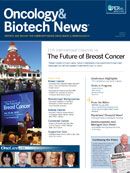Publication
Article
ENCODE Decodes DNA
Author(s):
A consortium of over 442 global investigators at 32 institutions recently reported results in over 30 publications of a decade of work from the Encyclopedia of DNA Elements project.
Andrew L. Pecora, MD
Editor-in-Chief
Oncology & Biotech News
Chief Innovations Officer, Professor, and Vice President of Cancer Services John Theurer Cancer Center at Hackensack University Medical Center
One of the better metaphors for the basis of life among multicellular organisms through DNA-directed protein synthesis uses the construct of chapters in a book, where DNA in embryonic stem cells have all of the chapters available for reading and more differentiated cells have fewer. Biologists have accepted the basic dogma of life creation through reading DNA by RNA that then directs protein synthesis. As with most initial dogma in science, the story is usually incomplete at first, and then tends to amaze the discoverer as the richness of the true story unfolds. A consortium of over 442 global investigators at 32 institutions recently reported results in over 30 publications of a decade of work from the ENCODE (Encyclopedia of DNA Elements) project that now requires a partial rewrite of the Watson and Crick dogma taught to all high school students around the globe (http://www.genome.gov/10005107; http://www.nature.com/encode).
ENCODE analyzed 147 different cell types from the human body using genome sequencing and assessing the functions of RNA and proteins on transcription. The Human Genome Project initially demonstrated that DNA consists of a strand of nearly three billion nucleic acids. It was thought that most of the nucleic acids were inactive or “filler” to connect the portions that were actually read to produce a protein (genes) or promoted reading (promoter regions). The initial surprise arising from the Human Genome Project was that there are only some 20,000 genes in the vast “sea” of nucleic acids making up a DNA strand. The number of “chapters” (genes) readable in a differentiated cell ranges from a low of 22% to a high of 67%. Now, the shocking surprise: the ENCODE project has discerned that the remaining (non-gene) DNA is not largely inactive, but, in “collaboration” with RNA and proteins, acts as signaling switches turning on and off gene transcription. Moreover, unlike the “paltry” 20,000 genes, there are nearly 4 million switches that control the genes.
These transformative findings necessitate a rethinking of “gene-based” diseases, including cancer. In addition to abnormalities in the genes themselves, it is quite likely that in many disease states, the genes are fine and it is the switches that are bad. Clinical benefits derived from work with epigenetic agents supports this contention. In addition to diseases, the field of regenerative medicine may be unleashed by learning more about the relevant switches that control pluripotency.
The great thing about science is how the apple cart of dogma constantly gets turned on its side by new findings. It took Einstein in physics to show Newton the incompleteness of his story in describing the workings of our universe, and now similarly, ENCODE has further illuminated the story of life.









